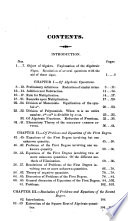 | Bourdon (M., Louis Pierre Marie) - Algebra - 1831 - 446 pages
...general. This law can be enunciated in another manner : viz. The square of any polynomial contains the square of the first term, plus twice the product of the first by the second, plus the square of the second; plus twice the product of each of the two first terms... | |
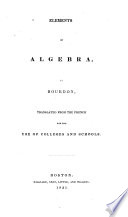 | Bourdon (M., Louis Pierre Marie) - Algebra - 1831 - 326 pages
...polynomial contains the square of its first term plus twice the product of its first term multiplied by the second, plus the • square of the second ; plus twice the product of each of the first two terms multiplied by the third, plus the square of the third ; and... | |
 | Charles Davies - Algebra - 1835 - 378 pages
...general. This law can be enunciated in another manner : viz. The square of any polynomial contains the square of the first term, plus twice the product of the first by the second, plus the square of the second ; plus twice the product of ilie first two terms by the... | |
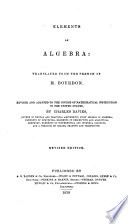 | Algebra - 1839 - 368 pages
...general. This Jaw can be enunciated in another manner : viz. The square of any polynomial contains the square of the first term, plus twice the product of the first by the second, plus the square of the second ; plus twice the product of thefirst two terms by the... | |
 | Charles Davies - Algebra - 1839 - 264 pages
...third forms, we see that the first member in each contains two terms of the square of a binomial, viz : the square of the first term plus twice the product of the 2nd term by the first. If, then, we take half the coefficient of x, viz : p, and square it, and add... | |
 | Roswell Park - Best books - 1841 - 722 pages
...by x + a, we shall have (x + a)3 = x3 + 2 ax + a' ; that is, the square of a binomial, is made up of the square of the first term, plus twice the product of the two terms, plus the square of the last term. This suggests the rule for extracting the square root... | |
 | Charles Davies - Algebra - 1842 - 284 pages
...third forms, we see that the first member in each contains two terms of the square of a binomial, viz : the square of the first term plus twice the product of the 2nd term by the first. If, then, we take half the coefficient of x, viz : p, and square it, and add... | |
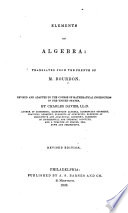 | Charles Davies - Algebra - 1842 - 368 pages
...square of any polynomial contains the square of the first term, plus twice the product of thefirst by the second, plus the square of the second ; plus twice the product of thefirst two terms by the third, plus the square of the third ; plus twice the product of... | |
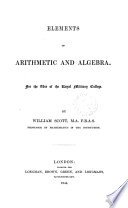 | William Scott - Algebra - 1844 - 568 pages
...(a+4+c+</)'=a2+2aA+42+2(a+4)c+c2+2(a+4+c)a"+d!, The square of a polynomial expression is consequently composed of the square of the first term, plus twice the product...term by the second, plus the square of the second term, plus twice the product of the sum of the first and second terms by the third, plus the square... | |
 | Davis Wasgatt Clark - 1844 - 394 pages
...Thus, V^+Zpx 2—x+p, and vV— 2px-\-p2=x— p. 324. We have also seen that the square of a binomial is equal to the square of the first term, plus twice the product of the two terms, plus the square of the last term. Thus, And the square of the residual, x— p, gives Hence,... | |
| |